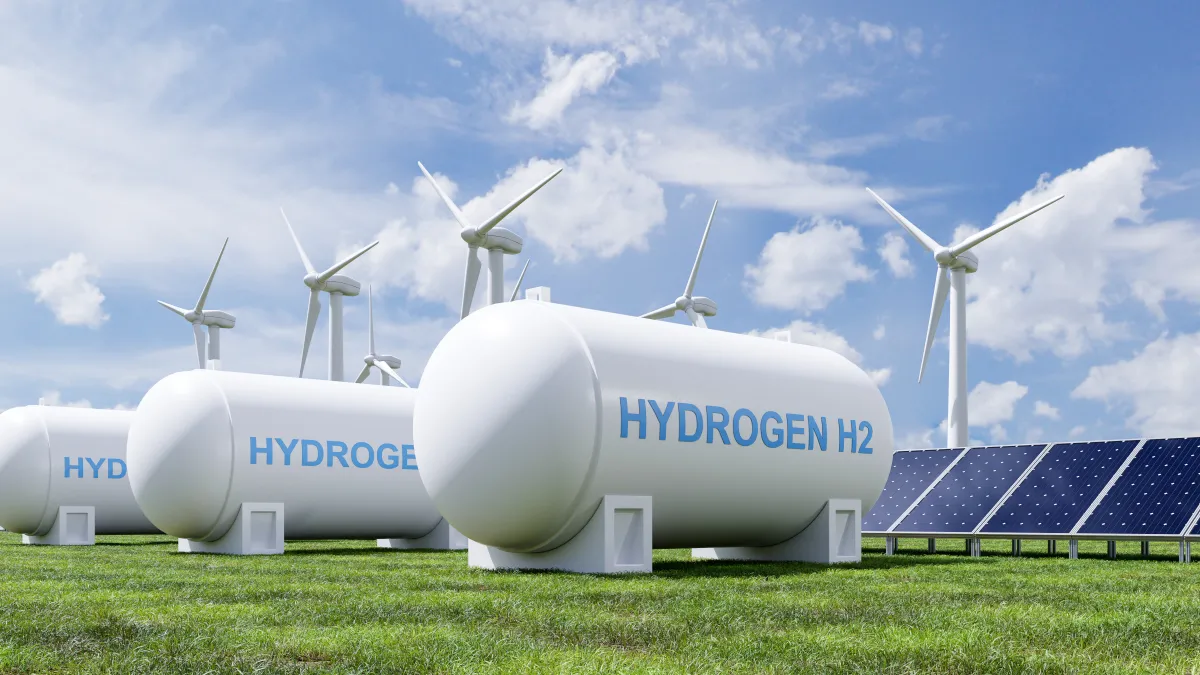Dive Brief:
-
Although transportation is the primary use case for hydrogen in the Los Angeles area, electric generation and the need for long-term, seasonal energy storage will likely spur hydrogen production at scale, according to an analysis released Tuesday by the Green Hydrogen Coalition, an industry group focused on deploying green hydrogen at scale.
-
Pipelines from potential storage and hydrogen production hubs like the Intermountain Power Project in Delta, Utah, will likely prove more cost effective than producing hydrogen closer to population centers in Southern California, the analysis said.
-
Strategic deployment of hydrogen infrastructure could create tens of thousands of new jobs and push the price of hydrogen to less than 70 cents a kilogram, according to Lily Backer, chief of staff and green hydrogen project manager at Strategen, a consulting group.
Dive Insight:
Green hydrogen, which is produced using renewable energy to drive electrolysis, could bring substantial benefits to Southern California. But getting there will require concerted policy and industry efforts, researchers told attendees of a Tuesday webinar hosted by the Green Hydrogen Coalition.
Analysis from the University of California, Irvine, concluded that green hydrogen could provide about 20% of the emissions reductions needed for Los Angeles to comply with federal smog standards, in addition to helping the state reach its decarbonization targets.
In a four-month period modeled by UC Irvine, the improved air quality would result in 27 fewer deaths, 960 fewer hospitalizations and 7,500 fewer lost work days, said Michael MacKinnon, a senior scientist in the advanced power and energy program at UC Irvine. These health benefits would drive some $2 million in savings to some of California’s most disadvantaged communities, he said.
Over time, the benefits realized could be as much as 10 times greater than the university’s analysis projected, MacKinnon said, but time and budget constraints limited the model to a hypothetical four months.
Developing a green hydrogen industry could also support more than 28,000 full-time jobs in the LA area, compared to the 22,000 jobs currently supported by the natural gas and refining industries, according to Jeffrey Reed, chief scientist for renewable fuels and energy storage at UC Irvine.
But to achieve these benefits at the lowest possible cost will require some as-yet realized developments — some of which are already in motion, Backer said. Although the primary driver of demand for hydrogen fuel in the LA area is transportation — heavy duty shipping, off-road vehicles, aviation and maritime shipping — early demand for hydrogen won’t reach critical mass without the participation of a single, large-scale offtaker willing to jump-start hydrogen production, Backer said. Potential offtakers could include fertilizer manufacturers or chemical refiners, but neither of these industries is present in Los Angles. That leaves the power sector as the most likely candidate, Backer said.
The Green Hydrogen Coalition’s analysis, which was part of the second phase of its HyBuild LA project, also concluded that the demand for hydrogen from Los Angeles would eventually require large-scale hydrogen storage in salt caverns that do not exist naturally in Los Angles. The cheapest solution for producing, storing and transporting hydrogen to Los Angeles will involve producing the molecule in less populated regions rich in solar energy resources, storing the hydrogen in a salt cavern complex in Delta, Utah, and transporting it to Los Angeles via pipelines the coalition called the “hydrogen backbone.”
However, Nick Connell, interim executive director of the Green Hydrogen Coalition, said existing regulatory frameworks are not suitable to the construction of interstate hydrogen pipelines.
Backer said the Green Hydrogen Coalition has no further research or analysis planned related to hydrogen infrastructure in southern California, but will continue to advocate for policy change and support a bid by the state to achieve a hydrogen hub designation from the Department of Energy.














